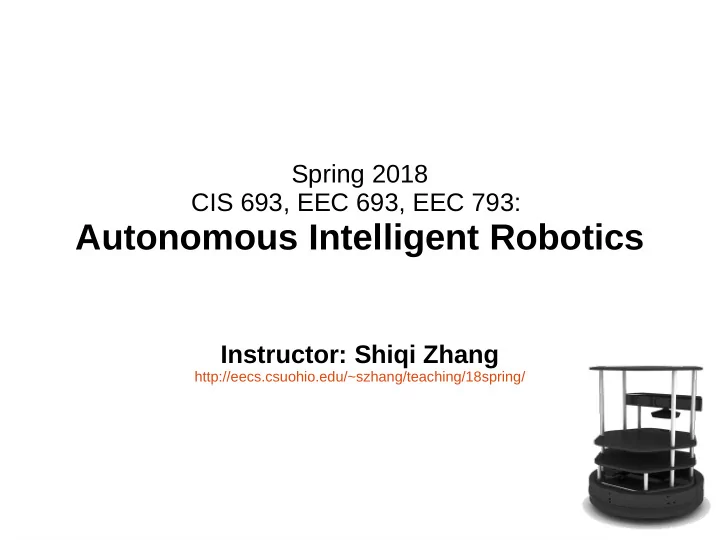

Spring 2018 CIS 693, EEC 693, EEC 793: Autonomous Intelligent Robotics Instructor: Shiqi Zhang http://eecs.csuohio.edu/~szhang/teaching/18spring/
Readings ● Grid-based vs. MCL – Efficiency – Continuous/discretized ● … it does not specify how the final position is chosen based on all these hypotheses. --- Mahmoud – Average of N-Best particles? – Report the best-match particle?
Mapping
Why Mapping? ● Learning maps is one of the fundamental problems in mobile robotics ● Maps allow robots to efficiently carry out their tasks, allow localization … ● Successful robot systems rely on maps for localization, path planning, activity planning etc.
The General Problem of Mapping What does the environment look like?
The General Problem of Mapping ● Formally, mapping involves, given the sensor data, = d { u , z , u , z , , u n z , } 1 1 2 2 n to calculate the most likely map * = m arg max P ( m | d ) m 7
Mapping as a Chicken and Egg Problem ● So far we learned how to estimate the pose of the vehicle given the data and the map. ● Mapping, however, involves to simultaneously estimate the pose of the vehicle and the map. ● The general problem is therefore denoted as the simultaneous localization and mapping problem (SLAM). 8
Types of SLAM-Problems ● Grid maps or scans [Lu & Milios, 97; Gutmann, 98: Thrun 98; Burgard, 99; Konolige & Gutmann, 00; Thrun, 00; Arras, 99; Haehnel, 01;…] ● Landmark-based 9 [Leonard et al., 98; Castelanos et al., 99: Dissanayake et al., 2001; Montemerlo et al., 2002;…
Problems in Mapping ● Sensor interpretation – How do we extract relevant information from raw sensor data? – How do we represent and integrate this information over time? ● Robot locations have to be estimated – How can we identify that we are at a previously visited place? – This problem is the so-called data association problem. 10
Incremental Updating of Occupancy Grids (Example) 11
Resulting Map Obtained with Ultrasound Sensors 12
Resulting Occupancy and Maximum Likelihood Map The maximum likelihood map is obtained by clipping the occupancy grid map at a threshold of 0.5 13
Occupancy Grids: From scans to maps 14
Tech Museum, San Jose CAD map occupancy grid map 15
Example Occupancy Map 16
● Occupancy grid maps are a popular approach to represent the environment of a mobile robot given known poses. ● In this approach each cell is considered independently from all others. ● It stores the posterior probability that the corresponding area in the environment is occupied. ● Occupancy grid maps can be learned efficiently using a probabilistic approach. ● They store in each cell the probability that a beam is reflected by this cell. 17
SLAM
The SLAM Problem A robot is exploring an unknown, static environment. Given: – The robot’s controls – Observations of nearby features Estimate: – Map of features – Path of the robot 19
Structure of the Landmark-based SLAM-Problem 20
Mapping with Raw Odometry 21
SLAM Applications Indoors Undersea Space Underground 22
Representations ● Grid maps or scans [Lu & Milios, 97; Gutmann, 98: Thrun 98; Burgard, 99; Konolige & Gutmann, 00; Thrun, 00; Arras, 99; Haehnel, 01;…] ● Landmark-based 23 [Leonard et al., 98; Castelanos et al., 99: Dissanayake et al., 2001; Montemerlo et al., 2002;…
Why is SLAM a hard problem? SLAM : robot path and map are both unknown Robot path error correlates errors in the map 24
Why is SLAM a hard problem? Robot pose uncertainty ● In the real world, the mapping between observations and landmarks is unknown ● Picking wrong data associations can have catastrophic consequences ● Pose error correlates data associations 25
SLAM: Simultaneous Localization and Mapping ● Full SLAM: Estimates entire path and map! p ( x , m | z , u ) 1 : t 1 : t 1 : t ● Online SLAM: ∫∫ ∫ = p ( x , m | z , u ) p ( x , m | z , u ) dx dx ... dx t 1 : t 1 : t 1 : t 1 : t 1 : t 1 2 t − 1 Integrations typically done one at a time Estimates most recent pose and map! 26
Graphical Model of Online SLAM: ∫∫ ∫ p ( x , m | z , u ) = p ( x , m | z , u ) dx dx ... dx t 1 : t 1 : t 1 : t 1 : t 1 : t 1 2 t − 1 27
Graphical Model of Full SLAM: p ( x , m | z , u ) 1 : t 1 : t 1 : t 28
Techniques for Generating Consistent Maps ● Scan matching ● EKF SLAM ● Fast-SLAM ● Probabilistic mapping with a single map and a posterior about poses Mapping + Localization ● Graph-SLAM, SEIFs 29
Scan Matching Maximize the likelihood of the i-th pose and map relative to the (i-1)-th pose and map. { } − [ t 1 ] ˆ ˆ ˆ = ⋅ x arg max p ( z | x , m ) p ( x | u , x ) t t t t t − 1 t − 1 x t robot motion current measurement map constructed so far ˆ t [ ] m Calculate the map according to “mapping with known poses” based on the poses and observations. 30
Recommend
More recommend